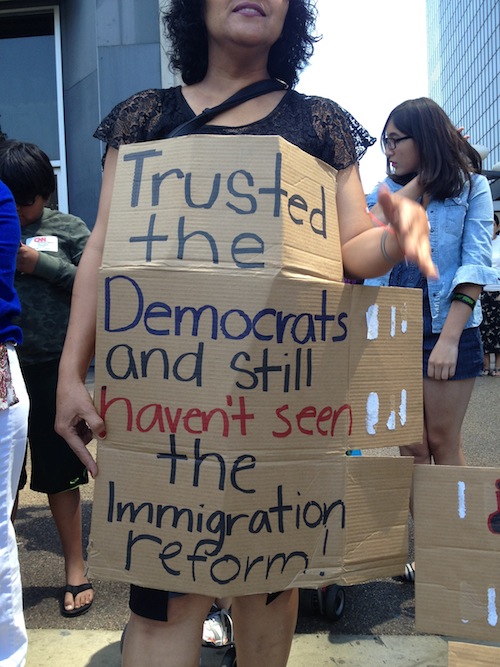Editor’s Note: California, which has the largest and most diverse student body in the nation, ranks near the bottom in per-pupil spending and academic performance. A number of recent initiatives promise to begin reversing these trends. This is the first in a series of NAM interviews with those involved in the state’s education reform movement. Ted Lempert is founder and executive director of Children Now, among the most influential advocacy groups for children in California. He spoke with NAM education editor Peter Schurmann.
In broad strokes, how would you characterize the discussion happening around education reform in our country today?
What’s changed in recent years is an understanding that every student has to get an excellent education to reach their full potential in today’s world. Forty or 50 years ago … you didn’t need to have an excellent education to reach your full potential. In today’s world, everybody needs a great education.
Is this why we’re seeing a renewed focus on education at the national level?
Yes. The reason more people are focusing on education today … [is that] there’s an assumption that this country is not going to work if every child doesn’t get a great education. A parent still wants to do right by their child and do everything they can; that still hasn’t changed. But now, if they don’t [get that education], it’s not just the parent or the child who loses out. The whole country suffers.
So there is consensus in the education reform world around that idea that every child needs a great education. Where are the major disagreements?
There is a fair amount of consensus that every child needs a great education, that key to that is great teachers and support services, and that because it’s taxpayer money there needs to be accountability. The argument is about different ways to get there. But to jump into that fray a little, I don’t think it’s fair to accuse someone with a lot of resources philanthropically who is trying to figure out a way to improve schools that they’re doing it for their own self interest. I do think there is a fair amount of agreement on goals, and that we’ve done a disservice by impugning motives.
One of the areas of focus among education reformers of late has been on increasing parent engagement. Why does this remain such a challenge?
We know the parent is the most important educator. And so, you want the parent as engaged as possible in the child’s education. But it’s easier said than done, and not because the parent doesn’t want to. They’re working like crazy to support the family, and education itself and what the kids are learning today can often outpace the parents pretty quick. Let me personalize this. I have a ton of advantages as a parent … and I find parent engagement a struggle, in terms of making sure I know what’s going on at school all the time, and in terms of my kids day-to-day schoolwork. The reality is it’s just really hard.
California has seen a number of positive steps recently with regard to education, from boosting school funding to improving standards. What else do you see on the horizon that excites you?
There’s more change going on in the next couple of years than there has been at least in the last 25 years, and most of it positive. I think the Local Control Funding Formula and Common Core, a change in the standards, a more holistic focus on school climate and attendance, early education … it’s all [moving] in a positive direction. The only words of caution I’d throw out are: First, let’s keep focused and not have an unnecessarily polarized political debate, and second, change is difficult. We’re changing a massive system, and there’s going to be hiccups and challenges.
What are the biggest challenges?
Well, looking specifically at [Local Control Funding Formula] for example … How do we make sure dollars are getting to the kids intended? Moreover, LCFF did not solve the major funding problem. California is still nowhere near the top 10 states in terms of funding.
Why does California rank so low in per-pupil funding?
It’s partly Prop. 13 … because rather than more funding coming locally like it did before Prop. 13, it comes from the state. And so you put education into the mix with all these other interests, and because it’s a state-funded system, people get confused. They say, ‘Well, we’re spending 40 percent. Isn’t that enough?’ Where, if you look at other state-funded systems, they’re spending more like 50 percent. So because so much money is coming from the state, it makes it harder for people to understand how much more we need. That said, I do think part of LCFF is setting the stage for further investment.
What advice do you have for reform advocates and for society in general with respect to improving education?
We as a society need to respect the folks who are doing the work and pay them well. They, in turn, need to understand that the larger community has a right to demand a certain amount of accountability and success because we’re paying for this. It concerns me when ed-reform gets translated into something that most of us advocates don’t believe. Teachers bear the brunt of what we as a society aren’t delivering for our children. District attorneys, police officers, and the army don’t buy their own supplies. This is a decision we’ve made. I’ve been at education conferences where teachers have said, ‘What you guys don’t understand is I don’t have time to go to the bathroom during the day.’ We have to get into that perspective. We have to get it.
Can you speak to the work that your organization is doing around education reform?
Children Now brings business and labor, ed reform and traditional ed reform groups, statewide and community groups and other often polarized groups together under our “Pro-Kid” umbrella. We coordinate the Children’s Movement of California, which played a critical role in the passage of the Local Control Funding Formula. Just as a parent does not view their child in siloes, we are working to break down the siloes between birth-5 and K-12 and the education and health worlds, and instead ensure that every child has access to the mix of high quality health and education services that they uniquely need to ensure they have the opportunity to reach their full potential.
Fast Facts on Education in California
Fifty-two percent of California’s 6.2 million students are Hispanic, 26 percent white, 10 percent Asian and 6 percent African American.
California ranks 49th out of 50 states in per-pupil funding.
Teacher salary in California for the 2011-2012 school year ranked 5th in the nation, averaging $68,500, according to the National Education Association.
Under the Local Control Funding Formula, districts will receive an average of $6,800 per student, with an additional 35 percent for English learners and low-income students. Districts where more than half of the student population are high need will receive an additional grant. View an overview of the LCFF.
In 2010, California joined 45 other states in adopting the Common Core State Standards. View an overview of the new standards and a timeline for implementation.
This article was first published on New America Network on Oct 11, 2013











